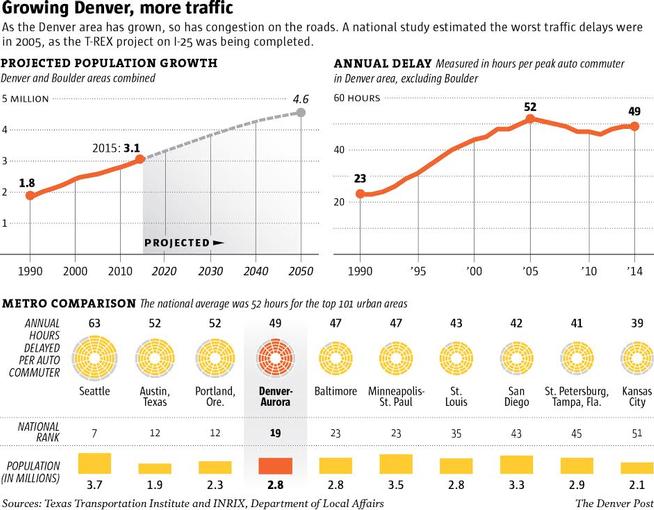Think traffic is bad around the Denver area? Just wait a decade or two
Article CAIRCO note:
Population-driven sprawl, traffic and congestion will be even worse in 25 years
Article publisher:
Denver Post
Article date:
20 December 2015
Article category:
Colorado News
Medium
Article Body:
...By most accounts, the region faces future demands that, if left unresolved, could drown the highway system with longer periods of unrelenting traffic.
A recent regional congestion report predicts that in coming decades, the volume of vehicles may grow so much that "the period from 2 to 4 p.m. in 2040 (will) have as much traffic as from 4 to 6 p.m. today." Meanwhile, that later period will worsen.

And the normal midday lull? By 2040, that period could seem as bad as today's morning rush hour, according to the October annual congestion report from the Denver Regional Council of Governments...
Its planning region has grown from about 2.2 million people in 1996 to an estimated 3.1 million now, an increase of about 45 percent.
By 2040, its projections estimate, the same area will be home to 4.3 million — an additional 38 percent increase — and a continuation of the 4,000 to 5,000 monthly net influx into metro Denver in recent years.
Douglas Rex, DRCOG's transportation planning director, compares the coming growth to absorbing the population of the Oklahoma City area...
The average commuter in the Denver metro area spent 49 hours sitting in traffic last year, according to the Texas Transportation Institute's Urban Mobility Scorecard. Denver ranked 19th among U.S. metro areas...
CAIRCO Notes
It is interesting that the article mentions population only twice. Yet clearly, regional population growth is driving the sprawl, congestion, and traffic increases that impact the Front Range.
The causative problem is population growth. Traffic congestion is simply a consequence of unending population growth within a finite geographical area.
Interestingly, American women voluntarily achieved replacement-level fertility (2.1 children per woman) in 1972. Population momentum (children growing up to have kids while their parents are still alive) would have caused U.S. population to increase to 255 million by 2020, and then to gradually decline to a sustainable level.
But we're already at 322 million people! What went wrong?
Quite simply, that's not the course Congress has chosen for us. U.S. population is being driven to double because of mass immigration, and it's not a pretty sight. That will mean twice as many houses, hospitals, schools, prisons, and cars. Every town, on average, will become twice as big.
The Chamber of Commerce and those who stand to profit from physical growth are undoubtedly elated at the business opportunities. Ultimately, of course, such physical growth can not be sustained and must stop. Coloradans may wish to express their opinion about mandated population growth to Congress as well as to their state legislators and local city councils.
CAIRCO Research
Population Driven to Double by Mass Immigration
Economic costs of legal and illegal immigration
Environment and the consequences of immigration-driven population growth
Population and Immigration Data, Projections and Graphs - Colorado
